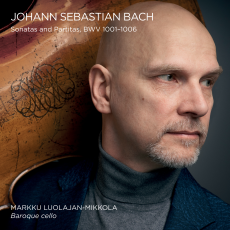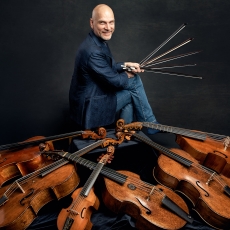Markku Luolajan-Mikkola - J.S. Bach: Complete Sonatas & Partitas - Fanfare
Markku Luolajan-Mikkola is a sensitive and scrupulous musician. A master of a number of string instruments, on the present recording he plays a Baroque cello made by Barak Norman in London around 1700. Luolajan-Mikkola gets a beautiful sound out of it, woodsy and rustic with marvelous resonance. The idea of transcribing Bach's unaccompanied violin works for cello is not a new one. There are extant arrangements dating back to the 19th century. According to Bach's son-in-law Johann Friedrich Agricola, the composer himself frequently played these pieces on the harpsichord, filling out the harmony as he deemed necessary. Luolajan-Mikkola's transcription is very faithful to the original. He has stated that Bach's slurs and accent marks are so idiomatic for string instruments that hardly anything needed to be changed.
The timings of Luolajan-Mikkola's performances are the slowest I've ever heard. Not that everything is uniformly slow. The Ciaccona for instance times in at about 15 minutes, a speed not unusual for performers on the modern violin. Indeed, the complete modern violin recording by Christiane Edinger is nearly as slow as Luolajan-Mikkola's. That said, Luolajan-Mikkola actually sounds much faster than her. Part of this is due to the greater weight of the cello's sound, leaving the impression of larger emphasis per note. Also, Luolajan-Mikkola has been influenced by the gamba works of French Baroque masters, including Marais and Forqueray, defining such matters as articulation, inflection, and stress-especially in dance movements. The result is that Luolajan-Mikkola's account has a rhythmic lift unusual in any performance of this music, making the Baroque cello an especially idiomatic vehicle for its interpretation.
There are definite advantages to performing the Sonatas and Partitas on Baroque cello. At first, I had a hard time getting the tone of the modern violin out of my head, but after a while the sound of Luolajan-Mikkola's instrument seemed perfectly natural. The fugues in the sonatas benefit immensely from the transcription. They seem rock-solid in weight and rich in tonal color, almost evoking the feeling of Bach's organ fugues. The allemandes in Luolajan-Mikkola's performance feel especially colloquial and rustic. Very impressive are the sarabandes, with a kind of timelessness that I'm sure would have been Bach's ideal for them. The correntes actually seem light and airy in contrast with much of the performance.
To discuss some of the musical highlights in the order they appear on the album, the Ciaccona of the Second Partita reminds me of Andrés Segovia's remark that you have to be 50 before you can play this music. The chiaroscuro of Luolajan-Mikkola's interpretation reminds me of the classic French painterly tones of Poussin. Much of the music is dark and in the cello's lower register, as if it is about to sink into a black hole. The general absence of vibrato often suggests agitated speech in its raspiness, rather than song. Here the emotional world is that of ancient Greek drama-there's nothing sweet about this performance. At times the speaker appears to be a seer, like Tiresias, whose words can shake heaven and earth.
The Second Sonata's Fuga in its even-tempered gentility evokes the world of Bach's Little Organ Book. There is the brightness of color in German Baroque church interiors. Luolajan-Mikkola here stresses the composer's equanimity. The Third Partita's Preludio goes at a wonderfully stately tempo, rather like a horse's trot. Bach seems to be observing the world with bemusement. It's all rather hip. In the "Gavotte en Rondeau," the double stops sound spicy and jazzy, as if played on a horn by the young Louis Armstrong. At the same time, the cello's sonority here is intensely lyrical. The Tempo di Borea (or Bourrée) of the First Partita possesses a dryness that helps you understand why Bach played this music on the harpsichord. Luolajan-Mikkola's tempo is crisp and energetic, like biting into a cold, fresh grape. Some of the figurations here sound like bass lines in 1960s rock. In the First Sonata's Fuga, marked Allegro, there is momentum reminiscent of the Fugue from theToccata, Adagio, and Fugue for organ. Luolajan-Mikkola gets some passages to sing as on a baritone saxophone. Occasionally a phrase curves as if it's being sculpted.
The Third Sonata's Fuga, in its stately working out, reminds me of the Passacaglia and Fugue in C Minor for organ. Luolajan-Mikkola is expressive without disturbing the music's majestic flow. Arturo Toscanini's very 19th-century comment-that the fugue is an artificial form, but Bach was a passionate man-has some bearing here. I believe that Bach saw the grandeur of God in the way the form of a fugue such as this one can encapsulate so much human experience. Luolajan-Mikkola's interpretation of it leaves you with a feeling of wonder.
The veteran sound engineer Arne Akselberg has contrived fine recorded sound on these CDs, close up yet warm and spacious. Of modern-violin albums of these works, my favorite is Nathan Milstein's monaural account. Among the stereo recordings, I prefer the elegant rendition by Felix Ayo. That Markku Luolajan-Mikkola's transcription of these works succeeds so beautifully is more proof of Artur Schnabel's remark that there is music greater than any possible performance of it. I hope that other cellists, on both Baroque and modern instruments, will take up these works and give us even more to ponder about Bach's genius. As a starting point in that musical dialogue, Luolajan-Mikkola's recording could hardly be bettered.

